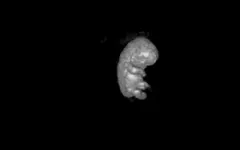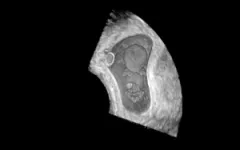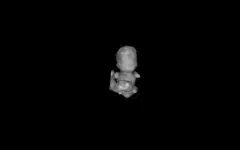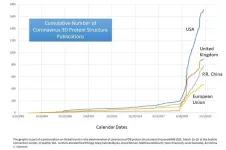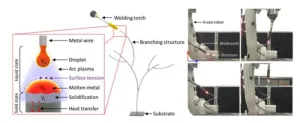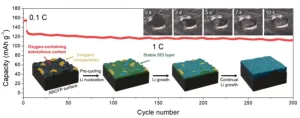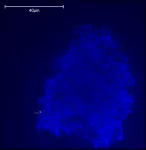(Press-News.org) World-first ‘phase change inks’ that could transform how we heat and cool buildings, homes and cars – to achieve sophisticated ‘passive climate’ control – have been developed, with enormous potential to help reduce energy use and global greenhouse gas emissions.
New research published in The Royal Society of Chemistry’s Journal of Materials Chemistry A led by Dr Mohammad Taha, documents proof-of-concept ‘phase change inks’ that use nanotechnology to control temperature in everyday environments. They achieve this by adjusting the amount of radiation that can pass through them, based on the surrounding environment.
Dr Taha said these inks could be used to develop coatings to achieve passive heating and cooling, reducing our need to rely on energy creation to regulate temperatures.
“Humans use a lot of energy to create and maintain comfortable environments – heating and cooling our buildings, homes, cars and even our bodies,” Dr Taha said.
“We can no longer only focus on energy generation from renewable resources to reduce our environmental impact. We also need to consider reducing our energy consumption as part of our proposed energy solutions, as the impacts of climate change become a reality.
“By engineering our inks to respond to their surroundings, we not only reduce the energy expenditure, but we also remove the need for auxiliary control systems to control temperatures, which is an additional energy waste.”
Passive climate control would enable comfortable living conditions without expending energy unnecessarily. For example, to provide comfortable heating in winter, the inks applied on a building façade could automatically transform to allow greater sun radiation to pass through during the day, and greater insulation to keep warmth in at night. In summer, they could transform to form a barrier to block heat radiation from the sun and the surrounding environment.
The versatile ‘phase change inks’ are a proof-of-concept that can be laminated, sprayed or added to paints and building materials. They could also be incorporated into clothing, regulating body temperature in extreme environments, or in the creation of large-scale, flexible and wearable electronic devices like bendable circuits, cameras and detectors, and gas and temperature sensors.
Dr Taha said: “Our research removes the previous restrictions on applying these inks on a large scale cheaply. It means existing structures and building materials can be retrofitted. With manufacturing interest, the inks could reach market in five to 10 years.
“Through collaboration with industry, we can scale up and integrate them into existing and new technologies as part of a holistic approach to tackling the world’s climate change energy challenges.
“The potential of this material is huge as it can be used for so many different purposes – like preventing heat build-up in laptop electronics or on car windshields. But the beauty of this material is that we can adjust its heat absorption properties to suit our needs.
“Already, a different type of phase change material is used to manufacture smart glass, but our new material means we can engineer smarter bricks and paint. This new nanotechnology can help retrofit existing buildings to make them more efficient. It’s better for the environment and sustainable for the future.”
The breakthrough was achieved by discovering how to modify one of the main components of ‘phase change materials’ – vanadium oxide (VO2). Phase change materials use triggers, like heat or electricity, to create enough energy for the material to transform itself under stress. However, phase change materials previously needed to be heated to very high temperatures for their ‘phase changing’ properties to be activated.
“We used our understanding of how these materials are put together to test how we could trigger the insulator to metal (IMT) reaction, where the material basically acts as a switch to block heat beyond a particular temperature – near-room temperature (30-40oC),” Dr Taha said.
Dr Taha said the next step will involve taking the research, patented by the University of Melbourne, to production.
END
'Nano inks' could passively control temperature in buildings, cars
World-first ‘phase change inks’ that could transform how we heat and cool buildings, homes and cars – to achieve sophisticated ‘passive climate’ control – have been developed, with potential to help reduce energy use and global greenhouse gas emissions
2023-03-27
ELSE PRESS RELEASES FROM THIS DATE:
Project helps thousands of people in England and France into employment and entrepreneurship
2023-03-27
New research led by the University of East Anglia (UEA) shows that large infrastructure projects which are the focus of the UK government’s levelling up agenda and include support for business start-ups, must also offer sustainable, local investment in deprived communities.
Through place-based micro-enterprise training and employment support over a longer time frame, lasting local impact can be demonstrated, according to the study’s policy recommendations.
Supporting people to return to their communities, increasing social cohesion within them, boosting digital literacy and enabling net zero jobs are also likely to play a role.
These goals can be easily ...
Embryos’ development is delayed in pregnancies that end in miscarriage
2023-03-27
Embryos in pregnancies that end in miscarriage take longer to develop in the womb than those in pregnancies that result in live births, according to new research published today (Monday) in Human Reproduction [1], one of the world’s leading reproductive medicine journals.
For the first time, researchers in The Netherlands have been able to look at the way embryos develop while pregnancies are ongoing. They used state-of-the-art imaging technology, including 3D ultrasound with high resolution transvaginal probes and ...
Global analysis of coronavirus protein research reveals how countries respond to disease
2023-03-27
In a new study, researchers examined how a country’s number of published 3D protein structures for coronaviruses, including the one responsible for COVID-19, correlated with its economic output and population. The findings reveal important insights into how different countries' research establishments respond to disease outbreaks and could be useful for planning responses to future pandemics.
The study showed that countries with larger economies generated more 3D structure determinations for the protein components ...
Shh! Intensive care incubators resonate sounds and risk damage to premature babies’ hearing, scientists say
2023-03-27
For vulnerable premature babies, an incubator in the neonatal intensive care unit (NICU) is a lifesaver, but the consequences can last a lifetime. Many studies have shown that the NICU is a noisy environment and that babies who spend time there have higher rates of hearing impairment, which can lead to delays in language acquisition. Scientists from Vienna, Hamburg, Munich, and Osnabruck set out to investigate the role of the incubator, an underestimated element in the soundscape that surrounds babies during their time in the NICU.
“The ...
Securing new metal 3D printing technology that drives the renaissance of the manufacturing industry!
2023-03-27
□ A research team led by Dr. Sang-woo Song, Dr. Chan-kyu Kim, Dr. Kang-myung Seo at the Department of Joining Technology of the Korea Institute of Materials Science(KIMS), a government-funded research institute under the Ministry of Science and ICT, has developed a foundational technology for controlling the volume of molten metal in the process of 3D printing metal using welding techniques. They achieved this through collaborative research with a research team led by Professor Young-tae Cho and Professor ...
Advanced technologies for longer-lasting electric vehicles
2023-03-27
Owing to the worldwide trend of utilizing electric vehicles, there has been a rise in demand for next-generation secondary batteries with higher capacity and faster charging than the lithium-ion batteries currently in use. Lithium metal batteries have been recognized as promising rechargeable batteries because lithium metal anode exhibits theoretical capacity 10 times higher than commercial graphite anode. During charging-discharging processes, however, lithium dendrites grow on the anode, leading to poor battery performance and short-circuit.
Dr. Sungho Lee, Head of the ...
The genetics of temperature adaptation: how does life thrive in extreme conditions?
2023-03-27
The history of the Earth has been one of physical extremes—extreme atmospheric conditions, extreme chemical environments, and extreme temperatures. There was a time when the Earth was so hot all the water was vapor, and the first rain only fell once the planet cooled enough. Soon after, life emerged and through it all, life has found a way. Today life is found almost everywhere on Earth we have looked; it is difficult to find places where life does not exist. The remarkable ability of life to adapt to variable conditions is one of its defining characteristics. Of its many adaptations, the ability of life to adapt to varying temperatures ...
Opening up a different conversation about violence
2023-03-27
20 years on from the invasion of Iraq, nearly 25 years since the Good Friday Agreement in Northern Ireland, and in the midst of war in Ukraine and contested questions about migration and the legacies of war, a brand new Centre for the Study of Violence will launch this week at the University of Bath.
Led by academics across the University’s Faculty of Humanities & Social Sciences, including political theorists, development and humanitarian scholars, plus crime, defence and security experts, the new Centre will be the first of its kind in the UK. It aims to help society rethink how violence operates and to find ways to imagine a more peaceful world.
The Centre ...
Students who played sports before the pandemic did better during lockdowns
2023-03-27
A history of participating in campus recreational sports can offset stress and contribute to academic competence even during high-stress periods such as a pandemic lockdown, shows a new study.
Researchers at the University of Waterloo found that participation in activities such as fitness classes and intramural and drop-in sports before the pandemic was linked to lower levels of stress and higher levels of perceived competence to handle challenges and master school workload during the lockdown.
The study used factor and regression analyses based on self-reported ...
What do the elements sound like? (video)
2023-03-26
INDIANAPOLIS, March 26, 2023 — In chemistry, we have He, Fe and Ca — but what about do, re and mi? Hauntingly beautiful melodies aren’t the first things that come to mind when looking at the periodic table of the elements. However, using a technique called data sonification, a recent college graduate has converted the visible light given off by the elements into audio, creating unique, complex sounds for each one. Today, the researcher reports the first step toward an interactive, musical periodic table.
The researcher will present his results at the spring meeting of the American Chemical Society (ACS). ACS Spring 2023 is a hybrid meeting ...
LAST 30 PRESS RELEASES:
Making lighter work of calculating fluid and heat flow
Normalizing blood sugar can halve heart attack risk
Lowering blood sugar cuts heart attack risk in people with prediabetes
Study links genetic variants to risk of blinding eye disease in premature infants
Non-opioid ‘pain sponge’ therapy halts cartilage degeneration and relieves chronic pain
AI can pick up cultural values by mimicking how kids learn
China’s ecological redlines offer fast track to 30 x 30 global conservation goal
Invisible indoor threats: emerging household contaminants and their growing risks to human health
Adding antibody treatment to chemo boosts outcomes for children with rare cancer
Germline pathogenic variants among women without a history of breast cancer
Tanning beds triple melanoma risk, potentially causing broad DNA damage
Unique bond identified as key to viral infection speed
Indoor tanning makes youthful skin much older on a genetic level
Mouse model sheds new light on the causes and potential solutions to human GI problems linked to muscular dystrophy
The Journal of Nuclear Medicine ahead-of-print tip sheet: December 12, 2025
Smarter tools for peering into the microscopic world
Applications open for funding to conduct research in the Kinsey Institute archives
Global measure underestimates the severity of food insecurity
Child survivors of critical illness are missing out on timely follow up care
Risk-based vs annual breast cancer screening / the WISDOM randomized clinical trial
University of Toronto launches Electric Vehicle Innovation Ontario to accelerate advanced EV technologies and build Canada’s innovation advantage
Early relapse predicts poor outcomes in aggressive blood cancer
American College of Lifestyle Medicine applauds two CMS models aligned with lifestyle medicine practice and reimbursement
Clinical trial finds cannabis use not a barrier to quitting nicotine vaping
Supplemental nutrition assistance program policies and food insecurity
Switching immune cells to “night mode” could limit damage after a heart attack, study suggests
URI-based Global RIghts Project report spotlights continued troubling trends in worldwide inhumane treatment
Neutrophils are less aggressive at night, explaining why nighttime heart attacks cause less damage than daytime events
Menopausal hormone therapy may not pose breast cancer risk for women with BRCA mutations
Mobile health tool may improve quality of life for adolescent and young adult breast cancer survivors
[Press-News.org] 'Nano inks' could passively control temperature in buildings, carsWorld-first ‘phase change inks’ that could transform how we heat and cool buildings, homes and cars – to achieve sophisticated ‘passive climate’ control – have been developed, with potential to help reduce energy use and global greenhouse gas emissions

